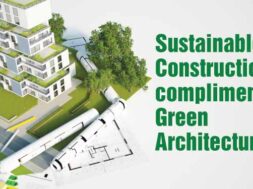Sustainable Construction complimenting Green Architecture

Interiors architects and construction specialists collaboratively share their views on how sustainability trends create avenues for green architecture and sustainable interior designs.
Interior design is becoming increasingly crucial as Indians’ design consciousness grows. People are becoming more aware of how interior designers can assist them in successfully organising and utilising areas while maintaining beauty. Customised items by numerous national and international designers, as well as organisations such as IKEA, have aided in the cause of beautifying interiors. Beautiful interiors are increasingly linked with homes.
Adhering to sustainable interiors
Interiors significantly impact the sustainability of homes and businesses since they are in charge of selecting the appropriate objects and materials for their surroundings. Sustainable practices in interior design and architecture demonstrate a dedication to environmental stewardship. Uttamaditya from U & I Interiors Pvt. Ltd. says of sustainable designs, “Sustainability for regular people comes via planning, whether for their life or their home.” It will help if you redefine your purpose more sustainably
and creatively without changing or deviating from sustainability. This makes your purchases or assets more sustainable in terms of your options.
Preety Gupta of Preety Gupta Architects uses this occasion to discuss how to complement contemporary materials and technologies while keeping sustainability in mind. She emphasises the importance of having things that may be reused and recycled later in interior design and architecture. It entirely depends on the client’s preferences and requirements regarding sustainable architecture.
Innovations help meet the project deadline
“Digital innovations and physical innovation are the two main components that are key to fulfilling project completion timelines,” says Aakash Trivedi of Metro Redesigners. Until the late 2000s, drawings and graphics were created with an older version of AutoCAD. Today, we can make realistic designs using 3D and 2D designs, as well as other applications. As a result, technology has emerged to improve design correctness. These advancements have also simplified project management and monitoring procedures.
“Second, social media and communication apps such as WhatsApp and others. “Nowadays, most clients prefer to communicate via WhatsApp and other social media platforms. “Even our merchants, carpenters, and labourers are updated solely through these chat programs,” Aakash explains. This, I believe, is how innovations have transformed and helped us fulfil deadlines. The rapid advancement of industrial innovations is continually changing project management and monitoring methods.
However, according to Devika, sustainability is not a top goal for everyone. It all comes down to choices. It’s all about being smart nowadays regarding products, technologies, and solutions for both urban metropolis and rural communities. “So, priority-wise, I feel city inhabitants need to pause and look around to realise where they stand.” They should reconsider their options. When employing designers, architects, and product designers, business owners must keep this in mind. As a result, it is our job to educate them on the significance of selecting the appropriate building material to ensure sustainability. Simply installing a glass block in the building will not be sufficient.
Adding energy efficiency to buildings through facades
“Facades enhance the visual appearance of their concept, are also practical, and are significantly responsible for the protection and water resistance of the structure because the facade is the outermost layer,” explains Santosh Kumar Sharma of Averox Design & Construction. Natural light, design and façade features can all be dealt with local materials rather than glass facades and other things, saving money for commercial offices and residential structures.
Choice of products and materials impacting the project cost
One of the most significant challenges in India is the cost. Home solutions, such as LED lights or other sustainable or recyclable goods, are pretty pricey for sustainable products. Devika emphasises here that being sustainable does not necessarily imply being green. It should produce less CO2 and use less electricity. As a result, the general issue of being sustainable costs more than traditional building.
Preety briefly discusses her clients’ fascinating requests for lighting, designs, and other parameters. These decisions have an impact on the client’s final project cost. As a result of the new options, we could not achieve sustainable building standards. Because even if we utilise sustainable building materials and eco-friendly structures such as cane, terra cotta, and many other things to add class and beauty, money remains an issue. As a result, their options and the limited budget make it difficult for the architects to strike a balance.
In agreement with the preceding conversation, Aakash says that the project cost also dictates our design job. We typically design digitally, using sketches or 2D or 3D technologies that necessitate VR. However, while working on low-budget projects, we make sure to include handmade designs as well because the technology allows VR designs to place a monetary burden on the client, shattering their entire budget.
As a result, we must be prepared with hand-drawn designs on iPad to give our consumers a broader design perspective and make appropriate choices or revisions. So, indeed, I feel that aligning their selections with the given money remains difficult.
Uttamaditya has a different opinion here. He emphasises that the architect must educate the client to understand their fundamental objective of developing sustainable
construction/building/homes. If customers insist on specific things despite the cost and other factors, we must adjust the design and other parameters accordingly.
The growing use of sustainable materials in furniture manufacture to protect the environment is driving the industry. Furthermore, the evolution of eco-friendly housing projects and the government’s infrastructure push are opening up many opportunities for interior designers, architects, cost-effective contractors, and sustainable building material providers, encapsulating the need for sustainable buildings in both the commercial and residential sectors.
Cookie Consent
We use cookies to personalize your experience. By continuing to visit this website you agree to our Terms & Conditions, Privacy Policy and Cookie Policy.










